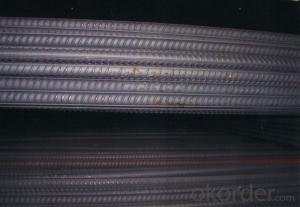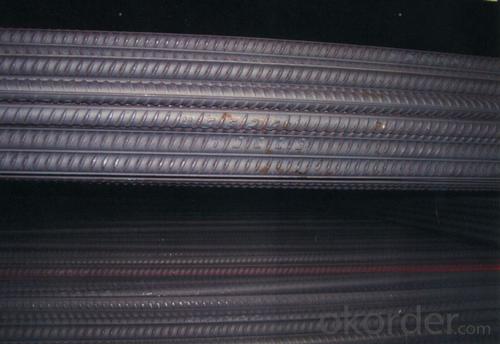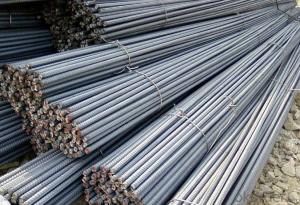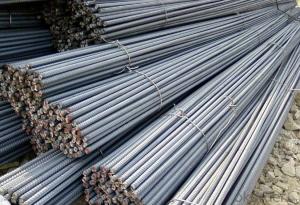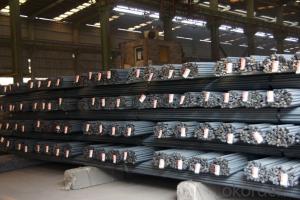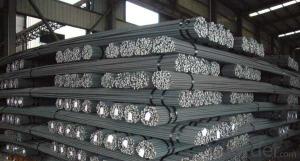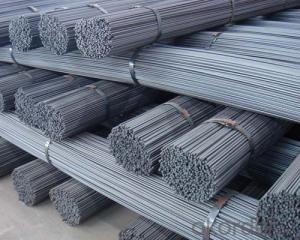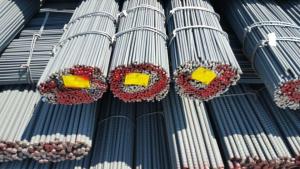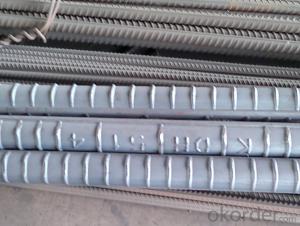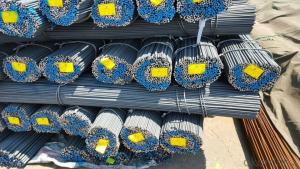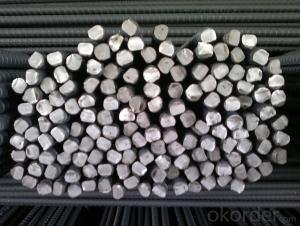Hot rolled ribbed steel bars (HRB400E~500)
- Loading Port:
- Tianjin
- Payment Terms:
- TT OR LC
- Min Order Qty:
- 1000 m.t.
- Supply Capability:
- 20000 m.t./month
OKorder Service Pledge
OKorder Financial Service
You Might Also Like
Reinforcing bar (Rebar) refers to the use of reinforced concrete and prestressed concrete with steel, its cross section is round, sometimes for the square with rounded corners. Including light round bar, ribbed steel bar, torsion bar. Reinforced concrete with steel bar is refers to the reinforced concrete reinforcement with straight or plate of strip steel, its appearance is divided into two kinds, light round steel and deformed steel delivery status for the straight bar and wire rod in two. Light round bar is really a small round steel and ordinary low carbon steel wire rod. Deformation is surface ribbed steel bar, usually with 2 longitudinal and cross rib of uniform distribution along the length direction. The appearance of cross rib is spiral, chevron, crescent 3 kinds. With nominal diameter mm number representation. Equals the nominal diameter is equal to the cross section deformation of reinforced light round bar nominal diameter. Reinforcement of nominal diameter is 8-50 mm, recommends to the diameter of 8, 12, 16, 20, 25, 32 and 40 mm. Steel grade: 20 mnsi, 20 mnsi MNV, 25, BS20MnSi. Rebar in concrete main tensile stress. Deformed bars as a result of the action of rib, and concrete have larger bonding ability, thus better able to withstand the role of external force. Steel is widely used in various building structures. Especially large, heavy, light thin wall and high-rise building structure.
Steel processing, steel processing to table and design review, check the material list for errors and omissions, for each steel bar to press
Material list to check whether meet the requirements, after these two checks, then press the material list sent out samples, trial production of qualified rear can batch production, processing and good reinforcement to neatly stacked in order.
Construction such as the need to be reinforced by substitution, must fully understand the design intent and substitution material performance, strictly abide by the current design code of reinforced concrete rules, not to area such as the substitution of low strength of high strength steel reinforcement. Any important parts of a reinforced substitution, shall agree with the consent of party a, design unit, and have a written notice shall be substitution.
(1) the steel surface should be clean, sticky oil, dirt, rust must be cleaned before use, can be combined with cold-drawn rust removal process.
(2) reinforced straightening, usable mechanical or manual straightening. After straightening of steel can not have local small bending, die bending, wavy, its surface scars should not be made of steel decreases by 5%.
(3) the steel bar cutting should be according to the number, diameter, length and quantity, the length is tie-in, first cutting long expected, by cutting short expected to reduce short head, and shorten the steel to save steel.
(4) steel hook or bend:
1) steel hook. There are three kinds of forms, respectively semicircle hook, hook and hook. After bending, bend endothelial contraction, skin
Extension, axis length is constant, bend arc formation, size is greater than the baiting size after bending, bending modifier should be considered.
Reinforced bending diameter of 2.5 d heart, straight part for 3 d. Steel hook increase the length of the theoretical calculation value: counter rotating round hook is 6.25 d, the straight
Hook is 3.5 d, the hook is 4.9 d.
(2) the bending of steel. Middle bending diameter D bend, not less than five times the diameter of the reinforcing steel bar.
(3) the stirrup. Stirrups should be done at the end of the hook, hook form should meet the design requirements. Stirrup adjustment, is the hook to increase the length and bending adjustment
Value or the difference between the two and, according to the amount of stirrup outsourcing size or inside the package size.
(4) reinforced blanking length should be according to the component size, concrete cover thickness, rebar bend modifier and hook to increase the length of the provisions as comprehensive exam
Lv.
A. straight reinforced blanking length = member length - protective layer thickness increase length + hook,
B. turn up steel blanking length = straight length - bend modifier + + inclined curved length increase length of hook,
C. blanking length = stirrup stirrup inner perimeter + modifier + hook to increase length of stirrup.
- Q: What is the purpose of ribbed steel rebars?
- The purpose of ribbed steel rebars is to provide reinforcement and strength to concrete structures. The ribs on the surface of the rebars enhance the bond between the steel and the concrete, preventing slippage and ensuring better load transfer and structural integrity.
- Q: What are the factors considered in designing with steel rebars?
- Some of the factors considered in designing with steel rebars include the structural requirements of the project, including the load that the rebars will need to support and the overall design and layout of the structure. Other factors include the type and grade of steel being used, the corrosion resistance properties, the spacing and arrangement of the rebars, and the connection details between the rebars and other structural elements. Additionally, factors such as construction techniques, budgetary constraints, and local building codes and regulations also influence the design considerations for steel rebars.
- Q: Can steel rebars be used in structures with limited construction space?
- Yes, steel rebars can be used in structures with limited construction space. Steel rebars are commonly used in reinforced concrete structures to provide tensile strength and reinforce the overall structural integrity. Due to their small size and flexibility, steel rebars can be easily maneuvered and installed in tight spaces. They can be bent, cut, or shaped to fit the specific requirements of the construction project. Additionally, steel rebars can be prefabricated off-site and transported to the construction site, which further facilitates their use in limited construction spaces. Overall, steel rebars are a versatile and practical choice for reinforcing structures with limited construction space.
- Q: What are the maintenance requirements for steel rebars in a structure?
- The maintenance requirements for steel rebars in a structure are crucial to ensure the stability and longevity of the building. Steel rebars, also known as reinforcing bars, are used to enhance the strength of concrete structures and resist tension forces. Here are some key maintenance requirements to consider: 1. Visual Inspection: Regular visual inspections should be conducted to detect any signs of corrosion, cracks, or damage in the rebars. This can be done by qualified personnel who have knowledge and experience in identifying structural issues. 2. Cleaning: The rebars should be kept clean from any debris, dirt, or chemicals that can accelerate corrosion. Adequate cleaning methods, such as using water and mild detergents, should be employed to maintain their condition. 3. Corrosion Protection: Steel rebars are susceptible to corrosion, especially in environments with high humidity, exposure to saltwater, or chemical pollutants. Applying protective coatings like epoxy or zinc can help prevent or delay corrosion, increasing the rebars' lifespan. 4. Repair or Replacement: If any rebars are found to be severely corroded, cracked, or damaged, it is essential to repair or replace them promptly. Ignoring these issues can compromise the structural integrity of the building and lead to safety hazards. 5. Monitoring: Continuous monitoring of the rebars' condition is recommended to detect any changes or deterioration over time. This can involve using advanced techniques like ultrasonic testing or electrical potential measurements to assess the rebars' integrity. 6. Proper Drainage: Ensuring proper drainage systems in the structure can help prevent water accumulation and reduce the chances of corrosion in the rebars. Properly designed and maintained gutters, downspouts, and waterproofing measures can help minimize water exposure. 7. Regular Maintenance Schedule: Establishing a regular maintenance schedule is crucial to ensure that all the necessary inspections, cleaning, and repairs are carried out systematically. This helps in identifying potential issues early on and taking corrective actions promptly. By adhering to these maintenance requirements, the steel rebars in a structure can be preserved, contributing to the overall safety, durability, and longevity of the building. Regular maintenance not only prevents costly repairs but also ensures the structural integrity required for the safety of occupants and the longevity of the structure.
- Q: How do steel rebars affect the shrinkage and creep of concrete?
- Steel rebars can have a significant impact on the shrinkage and creep behavior of concrete. Shrinkage refers to the reduction in volume of concrete due to the loss of moisture during the drying process, while creep refers to the time-dependent deformation of concrete under sustained load. The presence of steel rebars helps to mitigate the shrinkage of concrete. As the concrete shrinks, the rebars, being much stiffer than concrete, resist this shrinkage and provide a restraining effect. This restraint reduces the overall volume change of the concrete and helps to minimize cracking that may occur due to shrinkage. Additionally, the tensile strength of the steel rebars allows them to distribute stress and prevent localized cracking, further reducing the impact of shrinkage on the overall performance of the concrete. In terms of creep, the presence of steel rebars can increase the creep deformation of concrete. This is because the rebars can introduce additional stress and strain into the concrete, leading to greater creep deflections. However, the effect of steel rebars on creep is generally considered to be minor compared to other factors such as the mix design, water-cement ratio, and curing conditions. It is important to note that proper design and detailing of the reinforcement layout can help minimize the impact of steel rebars on shrinkage and creep. Adequate spacing and cover of rebars, as well as appropriate reinforcement ratios, can optimize the performance of both the concrete and the rebars. Additionally, the use of supplementary cementitious materials like fly ash or silica fume can also help reduce shrinkage and mitigate the impact of creep. In summary, steel rebars play a crucial role in minimizing the shrinkage-related issues in concrete by providing restraint and distributing stress. While they may increase the creep deformation of concrete, their impact is generally minor compared to other factors. Proper design and detailing of the reinforcement can optimize the performance of both concrete and steel rebars in terms of shrinkage and creep.
- Q: How are steel rebars protected against rust or corrosion?
- Steel rebars are protected against rust or corrosion through a process called corrosion protection, which involves either applying a protective coating or using corrosion-resistant materials such as stainless steel.
- Q: Can steel rebars be bent or shaped?
- Yes, steel rebars can be bent or shaped using various methods such as heat, mechanical force, or cold bending techniques.
- Q: Are there any environmental concerns related to the production of steel rebars?
- The production of steel rebars raises several environmental concerns, including the significant energy requirement for steel production. To produce steel, large amounts of fossil fuels like coal and natural gas are used, contributing to greenhouse gas emissions and climate change. Another concern is the extraction and mining of iron ore, the main raw material for steel production. This process can result in deforestation, habitat destruction, and soil erosion. Moreover, mining generates substantial waste material that can contaminate nearby water sources. In addition, the steel production process emits air pollutants such as particulate matter, sulfur dioxide, and nitrogen oxides. These pollutants can harm air quality and human health, causing respiratory problems and contributing to the formation of smog. It is worth noting that the steel industry is taking steps to address these environmental concerns. For instance, many steel producers are adopting more energy-efficient technologies and exploring alternative energy sources to reduce carbon emissions. Additionally, the recycling of steel is becoming more widespread, conserving resources and reducing the environmental impact of steel production. Overall, although the production of steel rebars does present environmental concerns, ongoing efforts are being made to mitigate these impacts and make the process more sustainable.
- Q: Are rebar bars = rebar?
- Rebar is only one of the reinforcing bars, and the reinforcing bars used in the construction site are distinguished from the appearance. They are mainly round steel (round steel bars) and plain steel (the appearance has lines, and the steel bars are divided into two kinds: thread and crescent).
- Q: Are steel rebars compatible with other construction materials?
- Yes, steel rebars are compatible with other construction materials. They are commonly used in conjunction with concrete to reinforce structures and provide additional strength and durability. Steel rebars can also be used with other materials such as wood, masonry, or composite materials, depending on the specific construction project requirements.
Send your message to us
Hot rolled ribbed steel bars (HRB400E~500)
- Loading Port:
- Tianjin
- Payment Terms:
- TT OR LC
- Min Order Qty:
- 1000 m.t.
- Supply Capability:
- 20000 m.t./month
OKorder Service Pledge
OKorder Financial Service
Similar products
Hot products
Hot Searches
Related keywords
